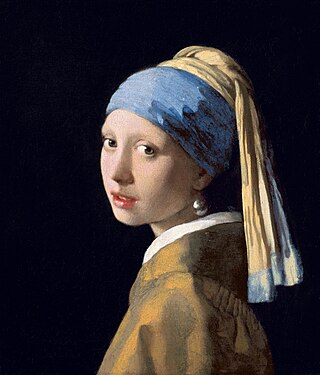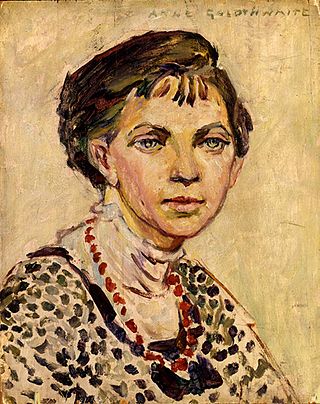
Berthe Marie Pauline Morisot was a French painter and a member of the circle of painters in Paris who became known as the Impressionists.

The history of painting reaches back in time to artifacts and artwork created by pre-historic artists, and spans all cultures. It represents a continuous, though periodically disrupted, tradition from Antiquity. Across cultures, continents, and millennia, the history of painting consists of an ongoing river of creativity that continues into the 21st century. Until the early 20th century it relied primarily on representational, religious and classical motifs, after which time more purely abstract and conceptual approaches gained favor.

Impressionism was a 19th-century art movement characterized by relatively small, thin, yet visible brush strokes, open composition, emphasis on accurate depiction of light in its changing qualities, ordinary subject matter, unusual visual angles, and inclusion of movement as a crucial element of human perception and experience. Impressionism originated with a group of Paris-based artists whose independent exhibitions brought them to prominence during the 1870s and 1880s.
This is an alphabetical index of articles related to painting.

Edgar Degas was a French Impressionist artist famous for his pastel drawings and oil paintings.

Modern art includes artistic work produced during the period extending roughly from the 1860s to the 1970s, and denotes the styles and philosophies of the art produced during that era. The term is usually associated with art in which the traditions of the past have been thrown aside in a spirit of experimentation. Modern artists experimented with new ways of seeing and with fresh ideas about the nature of materials and functions of art. A tendency away from the narrative, which was characteristic of the traditional arts, toward abstraction is characteristic of much modern art. More recent artistic production is often called contemporary art or postmodern art.

Post-Impressionism was a predominantly French art movement that developed roughly between 1886 and 1905, from the last Impressionist exhibition to the birth of Fauvism. Post-Impressionism emerged as a reaction against Impressionists' concern for the naturalistic depiction of light and colour. Its broad emphasis on abstract qualities or symbolic content means Post-Impressionism encompasses Les Nabis, Neo-Impressionism, Symbolism, Cloisonnism, the Pont-Aven School, and Synthetism, along with some later Impressionists' work. The movement's principal artists were Paul Cézanne, Paul Gauguin, Vincent van Gogh and Georges Seurat.
An art movement is a tendency or style in art with a specific common philosophy or goal, followed by a group of artists during a specific period of time, or, at least, with the heyday of the movement defined within a number of years. Art movements were especially important in modern art, when each consecutive movement was considered a new avant-garde movement. Western art had been, from the Renaissance up to the middle of the 19th century, underpinned by the logic of perspective and an attempt to reproduce an illusion of visible reality. By the end of the 19th century many artists felt a need to create a new style which would encompass the fundamental changes taking place in technology, science and philosophy.

The Neue Pinakothek is an art museum in Munich, Germany. Its focus is European Art of the 18th and 19th centuries, and it is one of the most important museums of art of the nineteenth century in the world.

Hendrik Emil (Rik) Wouters was a Belgian painter, sculptor and draughtsman. Wouters produced 200 paintings, drawings and sculptures in his 34 years before his illness-caused death. he died partway through the First World War on 11 July 1916 in Amsterdam. A sculptor, painter, draughtsman and etcher of typically fauvist style, Wouters' art resembled the works of artists including Henri Matisse, Paul Cézanne and André Derain- the "forefathers" of Fauvism.
Painting – artwork in which paint or other medium has been applied to a surface, and in which area and composition are two primary considerations.

The history of Western painting represents a continuous, though disrupted, tradition from antiquity until the present time. Until the mid-19th century it was primarily concerned with representational and Classical modes of production, after which time more modern, abstract and conceptual forms gained favor.

Miss La La at the Cirque Fernando is an oil on canvas painting by the French Impressionist artist Edgar Degas. Painted in 1879 and exhibited at the Fourth Impressionist Exhibition in Paris that same year, it is now in the collection of the National Gallery in London. It is Degas's only circus painting, and Miss La La is the only identifiable person of color in Degas's works. The special identity of Miss La La and the great skills Degas used in painting her performance in the circus made this piece of art important, widely appreciated but, at the same time, controversial.

20th-century Western painting begins with the heritage of late-19th-century painters Vincent van Gogh, Paul Cézanne, Paul Gauguin, Georges Seurat, Henri de Toulouse-Lautrec, and others who were essential for the development of modern art. At the beginning of the 20th century, Henri Matisse and several other young artists including the pre-cubist Georges Braque, André Derain, Raoul Dufy and Maurice de Vlaminck, revolutionized the Paris art world with "wild", multi-colored, expressive landscapes and figure paintings that the critics called Fauvism. Matisse's second version of The Dance signified a key point in his career and in the development of modern painting. It reflected Matisse's incipient fascination with primitive art: the intense warm color of the figures against the cool blue-green background and the rhythmical succession of the dancing nudes convey the feelings of emotional liberation and hedonism.

Fauvism is the style of les Fauves, a group of early 20th-century modern artists whose works emphasized painterly qualities and strong colour over the representational or realistic values retained by Impressionism. While Fauvism as a style began around 1904 and continued beyond 1910, the movement as such lasted only a few years, 1905–1908, and had three exhibitions. The leaders of the movement were André Derain and Henri Matisse.

Anne Goldthwaite was an American painter and printmaker and an advocate of women's rights and equal rights. Goldthwaite studied art in New York City. She then moved to Paris where she studied modern art, including Fauvism and Cubism, and became a member of a circle that included Gertrude Stein, Henri Matisse, and Pablo Picasso. She was a member of a group of artists that called themselves Académie Moderne and held annual exhibitions.
Victor Alfred Paul Vignon was a French Impressionist landscape painter and graphic artist. He was involved with the impressionism movement and its protagonists, as he exhibited at the fifth, sixth, seventh, and eight Paris Impressionist Exhibitions from 1880 to 1886.
Woman Ironing is a 1904 oil painting by Pablo Picasso that was completed during the artist's Blue Period (1901—1904). This evocative image, painted in neutral tones of blue and gray, depicts an emaciated woman with hollowed eyes, sunken cheeks, and bent form, as she presses down on an iron with all her will. A recurrent subject matter for Picasso during this time is the desolation of social outsiders. This painting, as the rest of his works of the Blue Period, is inspired by his life in Spain but was painted in Paris.

Flemish Expressionism, also referred to as Belgian Expressionism, was one of the dominant art styles in Flanders during the interbellum. Influenced by artists like James Ensor and the early works of Vincent van Gogh, it was a distinct contemporary of German Expressionism. Contrary to the more rebellious and erotic nature of many German Expressionist works, the Flemish art of the School of Latem was more oriented towards the farming life, and was expressed in earthy colours and vigorous brushwork. It was also in general more oriented towards France and Brussels than to Germany, and incorporated elements of Fauvism and Cubism, for example the interest in "primitive" art, of both the ethnic and folk traditions. Flemish Expressionists like Spilliaert were more influenced by Ensor and Symbolism, or like Wouters were closer to the vibrant colours used by the Fauvists. The main proponents were Gust De Smet, Constant Permeke and Frits Van den Berghe.















